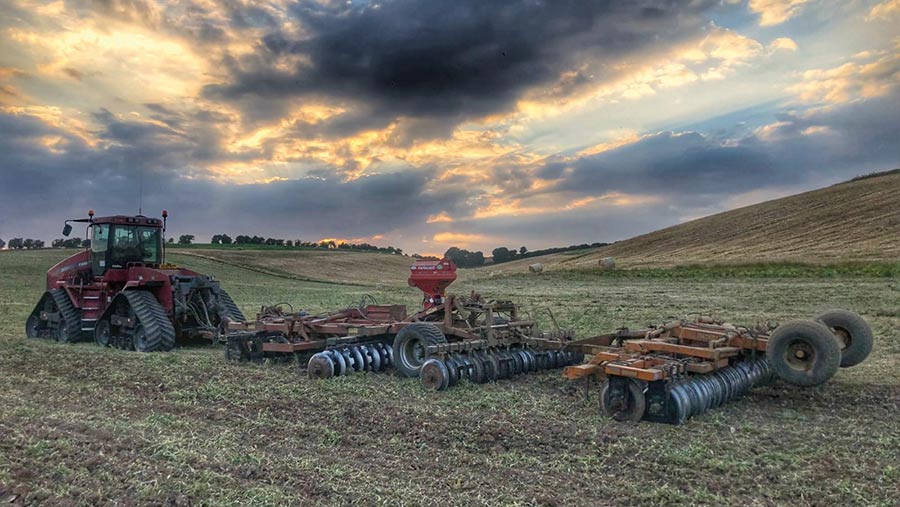Why Holl oilseed rape is working for winning grower
 © Mark Stubbbs
© Mark Stubbbs Lincolnshire grower Mark Stubbs switched to growing high oleic low linoleic (Holl) oilseed rape varieties for the chance to earn a premium price and now sets an ambitious target yield of more than 5t/ha.
After a successful debut with the specialist crop, he hasn’t looked back, although he has continued to grow a small area of the normal hybrid Exclaim on a coastal farm where the rotation isn’t suitable for Holl types.
Holl varieties produce healthy rapeseed oil that is favoured by the food industry.
See also: Why one Norfolk grower has kept oilseed rape in his rotation
Mr Stubbs managed to achieve a yield of 6.77t/ha with variety V316OL last year, coming second in the national Yield Enhancement Network (YEN) competition, and he now has 162ha of the latest Holl variety V367OL in the ground at Calcethorpe on the Lincolnshire Wolds this season.
“As that and previous results show, growing Holl varieties doesn’t mean that you have to accept lower yields,” he says.
Icing on the cake
The price premium of £25/t he describes as the icing on the cake, as he has been able to get good performance from growing Holl crops in the same way as normal oilseed rape, paying close attention to crop establishment.
“It worked very well for us right from the start. So we’ve carried on growing it.
“This year, we have the new line V367OL, which brings the pod shatter-resistance characteristic with it, so should minimise volunteer numbers,” he says.
Farm facts
A&C Stubbs & Sons, Manor Farm, Calcethorpe
- 695ha of owned, tenanted and farm business tenancy (FBT) land
- Seeking more land on either FBT or contract farm basis
- Winter wheat, winter oilseed rape, spring barley, spring oats and vining peas
- 40% oilseed rape, 40% winter wheat, 20% spring cropping
- Haulage business
- Contract muck spreading
To prevent contamination, any Holl variety has to be grown on land that has had a four- to five-year break from conventional oilseed rape and so won’t cause any issues with volunteers.
“Our Wolds land is clear, so we can grow it here without any concerns.
“We move it at harvest, so don’t have to segregate it in storage,” he adds.
Drilling date
Otherwise, the agronomy is the same for any high-yielding oilseed rape crop, with no additional costs or treatments.
Mr Stubbs targets a drilling date of 12 August and a seed rate of 45 seeds/sq m, but will delay if there’s no rain forecast.
“For the past two years, we’ve been a bit later than that.
“Establishment may have suffered a bit as a result, but the upside this year is that the two-week delay meant the crop wasn’t in flower when we had the late frosts in April,” he says.
Last year, he recorded a 0.25t/ha yield reduction from late spring frosts, so he is hoping that any damage has been limited this year.
Depending on the conditions in the autumn, cabbage stem flea beetles can be troublesome and he does see some shot-holing in young plants.
“If we’ve got our establishment right, the plants grow away from the pest. We have low levels of larvae in the crop, but not enough to worry about,” adds Mr Stubbs.
Establishment system
He uses a one-pass establishment system based on a Discordon, rolling immediately behind it to conserve moisture.
Plenty of farmyard manure has always been used, so soils are well-structured and moisture retentive.
“We’re doing a trial this year looking at the use of poultry manure, applied both before and after drilling, to see what effect it has,” he says.
Autumn herbicide use is usually Centurion Max (clethodim) followed by Astrokerb (propyzamide + aminopyralid), with a fungicide included with the second treatment if phoma disease thresholds have been reached.
This year’s cold April temperatures did slow spring growth and may result in a change to his planned sclerotinia strategy, in accordance with the crop’s flowering pattern.
“I always budget on two sprays. The first goes on just before full flowering, with the second being applied three to four weeks later.
“But it all depends on the weather and the likelihood of petal stick occurring – we may only need one,” adds Mr Stubbs.
Market price
An oilseed rape price in excess of £400/t is always welcome, so the current market conditions are good news for those who’ve stuck with the crop, he says.
His Holl crop is grown on contract for United Oilseeds and is moved at harvest to a store just 32km away.
“I can set the price at a time of my choosing. In the past, that’s often been just before harvest,” he says.
Replacement seed guarantee schemes – a feature of the past two years – that pay compensation if a crop fails have been taken up by Mr Stubbs, but not required.
“I’ve only ever lost one oilseed rape crop and that was because I shouldn’t have attempted to drill it in the first place,” he adds.
What is Holl oilseed rape?
High oleic, low linoleic (Holl) oilseed rape has a specialist fatty acid oil profile and is favoured by food service companies and food manufacturers.
With the oil having low levels of saturated fat and only traces of trans fats, it is seen as a healthier option where fried and processed foods are produced.
For the food industry, it also has greater stability and offers better frying performance and a longer frying life, while having no differences to other oils in terms of taste or colour.
Just one Holl variety, V316OL, can be found on the AHDB Recommended List.
Others are available and growers will have to refer to the breeder, Bayer CropScience, for more information on gross output and agronomic features.
Buy-back contracts are available from United Oilseeds and other merchants throughout the country.

